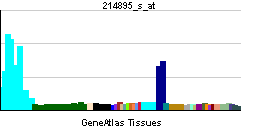ADAM10
| ADAM metallopeptidase domain 10 | |||||||||||||
|---|---|---|---|---|---|---|---|---|---|---|---|---|---|
 PDB rendering based on 2ao7. | |||||||||||||
| |||||||||||||
| Identifiers | |||||||||||||
| Symbols | ADAM10 ; CD156c; HsT18717; MADM; kuz | ||||||||||||
| External IDs | Template:OMIM5 Template:MGI HomoloGene: 865 | ||||||||||||
| RNA expression pattern | |||||||||||||
 | |||||||||||||
 | |||||||||||||
 | |||||||||||||
| More reference expression data | |||||||||||||
| Orthologs | |||||||||||||
| Template:GNF Ortholog box | |||||||||||||
| Species | Human | Mouse | |||||||||||
| Entrez | n/a | n/a | |||||||||||
| Ensembl | n/a | n/a | |||||||||||
| UniProt | n/a | n/a | |||||||||||
| RefSeq (mRNA) | n/a | n/a | |||||||||||
| RefSeq (protein) | n/a | n/a | |||||||||||
| Location (UCSC) | n/a | n/a | |||||||||||
| PubMed search | n/a | n/a | |||||||||||
ADAM metallopeptidase domain 10, also known as ADAM10, is a human gene.[1]
Members of the ADAM family are cell surface proteins with a unique structure possessing both potential adhesion and protease domains. This gene encodes and ADAM family member that cleaves many proteins including TNF-alpha and E-cadherin.[1]
See also
References
Further reading
- Wolfsberg TG, Primakoff P, Myles DG, White JM (1995). "ADAM, a novel family of membrane proteins containing A Disintegrin And Metalloprotease domain: multipotential functions in cell-cell and cell-matrix interactions". J. Cell Biol. 131 (2): 275–8. PMID 7593158.
- O'Bryan JP, Fridell YW, Koski R; et al. (1995). "The transforming receptor tyrosine kinase, Axl, is post-translationally regulated by proteolytic cleavage". J. Biol. Chem. 270 (2): 551–7. PMID 7822279.
- Howard L, Lu X, Mitchell S; et al. (1996). "Molecular cloning of MADM: a catalytically active mammalian disintegrin-metalloprotease expressed in various cell types". Biochem. J. 317 ( Pt 1): 45–50. PMID 8694785.
- McKie N, Edwards T, Dallas DJ; et al. (1997). "Expression of members of a novel membrane linked metalloproteinase family (ADAM) in human articular chondrocytes". Biochem. Biophys. Res. Commun. 230 (2): 335–9. doi:10.1006/bbrc.1996.5957. PMID 9016778.
- Rosendahl MS, Ko SC, Long DL; et al. (1997). "Identification and characterization of a pro-tumor necrosis factor-alpha-processing enzyme from the ADAM family of zinc metalloproteases". J. Biol. Chem. 272 (39): 24588–93. PMID 9305925.
- Yamazaki K, Mizui Y, Tanaka I (1998). "Radiation hybrid mapping of human ADAM10 gene to chromosome 15". Genomics. 45 (2): 457–9. doi:10.1006/geno.1997.4910. PMID 9344679.
- Yamazaki K, Mizui Y, Sagane K, Tanaka I (1998). "Assignment of a disintegrin and metalloproteinase domain 10 (Adam10) gene to mouse chromosome 9". Genomics. 46 (3): 528–9. doi:10.1006/geno.1997.5043. PMID 9441766.
- Yavari R, Adida C, Bray-Ward P; et al. (1999). "Human metalloprotease-disintegrin Kuzbanian regulates sympathoadrenal cell fate in development and neoplasia". Hum. Mol. Genet. 7 (7): 1161–7. PMID 9618175.
- Dallas DJ, Genever PG, Patton AJ; et al. (1999). "Localization of ADAM10 and Notch receptors in bone". Bone. 25 (1): 9–15. PMID 10423016.
- Dias Neto E, Correa RG, Verjovski-Almeida S; et al. (2000). "Shotgun sequencing of the human transcriptome with ORF expressed sequence tags". Proc. Natl. Acad. Sci. U.S.A. 97 (7): 3491–6. PMID 10737800.
- Hattori M, Osterfield M, Flanagan JG (2000). "Regulated cleavage of a contact-mediated axon repellent". Science. 289 (5483): 1360–5. PMID 10958785.
- Vincent B, Paitel E, Saftig P; et al. (2001). "The disintegrins ADAM10 and TACE contribute to the constitutive and phorbol ester-regulated normal cleavage of the cellular prion protein". J. Biol. Chem. 276 (41): 37743–6. doi:10.1074/jbc.M105677200. PMID 11477090.
- Chubinskaya S, Mikhail R, Deutsch A, Tindal MH (2001). "ADAM-10 protein is present in human articular cartilage primarily in the membrane-bound form and is upregulated in osteoarthritis and in response to IL-1alpha in bovine nasal cartilage". J. Histochem. Cytochem. 49 (9): 1165–76. PMID 11511685.
- Lemjabbar H, Basbaum C (2002). "Platelet-activating factor receptor and ADAM10 mediate responses to Staphylococcus aureus in epithelial cells". Nat. Med. 8 (1): 41–6. doi:10.1038/nm0102-41. PMID 11786905.
- Arndt M, Lendeckel U, Röcken C; et al. (2002). "Altered expression of ADAMs (A Disintegrin And Metalloproteinase) in fibrillating human atria". Circulation. 105 (6): 720–5. PMID 11839628.
- Colciaghi F, Borroni B, Pastorino L; et al. (2002). "[alpha]-Secretase ADAM10 as well as [alpha]APPs is reduced in platelets and CSF of Alzheimer disease patients". Mol. Med. 8 (2): 67–74. PMID 12080182.
- Lim R, Winteringham LN, Williams JH; et al. (2002). "MADM, a novel adaptor protein that mediates phosphorylation of the 14-3-3 binding site of myeloid leukemia factor 1". J. Biol. Chem. 277 (43): 40997–1008. doi:10.1074/jbc.M206041200. PMID 12176995.
- Gatta LB, Albertini A, Ravid R, Finazzi D (2003). "Levels of beta-secretase BACE and alpha-secretase ADAM10 mRNAs in Alzheimer hippocampus". Neuroreport. 13 (16): 2031–3. PMID 12438920.
- Gutwein P, Mechtersheimer S, Riedle S; et al. (2003). "ADAM10-mediated cleavage of L1 adhesion molecule at the cell surface and in released membrane vesicles". FASEB J. 17 (2): 292–4. doi:10.1096/fj.02-0430fje. PMID 12475894.
| Stub icon | This membrane protein–related article is a stub. You can help Wikipedia by expanding it. |
This article incorporates text from the United States National Library of Medicine, which is in the public domain.